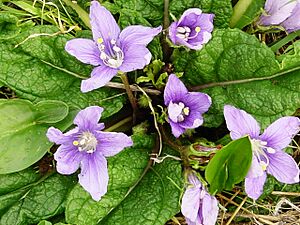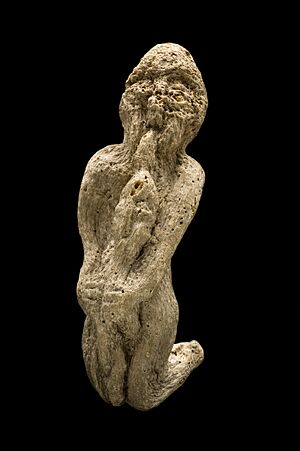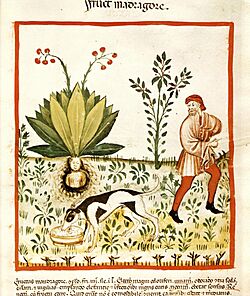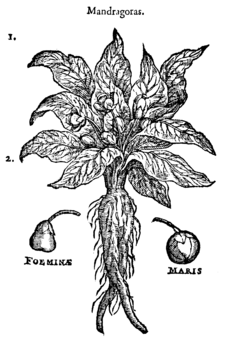Mandrake facts for kids


A mandrake is the root of a plant, historically derived either from plants of the genus Mandragora (in the Solanaceae family) found in the Mediterranean region, or from other species, such as Bryonia alba (the English mandrake, in the Cucurbitaceae family) or the American mandrake (Podophyllum peltatum in the Berberidaceae family) which have similar properties. The plants from which the root is obtained are also called "mandrakes". Mediterranean mandrakes are perennial herbaceous plants with ovate leaves arranged in a rosette, a thick upright root, often branched, and bell-shaped flowers followed by yellow or orange berries. They have been placed in different species by different authors. They are highly variable perennial herbaceous plants with long thick roots (often branched) and almost no stem. The leaves are borne in a basal rosette, and are variable in size and shape, with a maximum length of 45 cm (18 in). They are usually either elliptical in shape or wider towards the end (obovate), with varying degrees of hairiness.
Because the shape of mandrakes' roots often resembles human figures, they have been associated with magic rituals throughout history, including present-day contemporary pagan traditions.
The English name of the plant derives from Latin mandragora, related to the French main-de-gloire (hand of glory). In German, it is known as alraune ('all-rune' or 'elf-rune'), referring to the plant's folkloric ability to impart wisdom. Certain sources cite the Dutch name pisdifje ('brain thief'), claiming the plant grows from the brains of dead thieves, or the droppings of those hung on the gallows.
Toxicity
All species of Mandragora contain highly biologically active alkaloids, tropane alkaloids in particular. The alkaloids make the plant, in particular the root and leaves, poisonous. Anticholinergic properties can lead to asphyxiation. Accidental poisoning is not uncommon. Ingesting mandrake root is likely to have other adverse effects such as vomiting and diarrhea. The alkaloid concentration varies between plant samples. Clinical reports of the effects of consumption of Mediterranean mandrake include severe symptoms similar to those of atropine poisoning, including blurred vision, dilation of the pupils (mydriasis), dryness of the mouth, difficulty in urinating, dizziness, headache, vomiting, blushing and a rapid heart rate (tachycardia). Hyperactivity and hallucinations occurred in the majority of patients.
Folklore
In sufficient quantities, the root induces a state of unconsciousness and was used as an anaesthetic for surgery in ancient times. In the past, juice from the finely grated root was applied externally to relieve rheumatic pains. It was used internally to treat melancholy, convulsions, and mania. When taken internally in large doses it was said to excite delirium and madness.
In the past, mandrake was often made into amulets which were believed to bring good fortune, cure sterility, etc. In one superstition, people who pull up this root will be condemned to hell, and the mandrake root would scream and cry as it was pulled from the ground, killing anyone who heard it. Therefore, in the past, people have tied the roots to the bodies of animals and then used these animals to pull the roots from the soil.
The ancient Greeks burned mandrake as incense.
Magic and witchcraft

According to the legend, when the root is dug up, it screams and kills all who hear it. Literature includes complex directions for harvesting a mandrake root in relative safety. For example, Josephus (circa 37–100 AD) of Jerusalem gives the following directions for pulling it up:
A furrow must be dug around the root until its lower part is exposed, then a dog is tied to it, after which the person tying the dog must get away. The dog then endeavours to follow him, and so easily pulls up the root, but dies suddenly instead of his master. After this, the root can be handled without fear.
In Medieval times, mandrake was considered a key ingredient in a multitude of witches' flying ointment recipes as well as a primary component of magical potions and brews. These were entheogenic preparations used in European witchcraft for their mind-altering effects. Starting in the Late Middle Ages and thereafter, some believed that witches applied these ointments or ingested these potions to help them fly to gatherings with other witches, meet with the Devil, or to experience bacchanalian carousal.
Romani people use mandrake as a love amulet.


